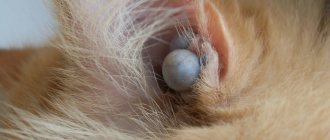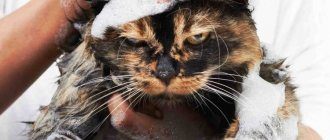Why can't you hug and cuddle cats? It would seem that the answer is clear by default, at least when it comes to stray animals that have acquired infections and are infected with worms. But a domestic cat can suffer from exactly the same diseases. Moreover, according to statistics, only 70% of owners regularly consult with veterinarians, and even fewer remember annual vaccinations - only a third of owners.
Is it possible to hug cats and cats in principle?
The answer is simple - of course, you can, because many cats are thrilled by tactile sensations. You may get the feeling that these cute creatures can rub against their owner for hours. These pets always climb onto a person’s lap when a person sits down, they can even hug him in a fit of feline devotion and love.
For such cats, hugs from their owners are one of the most pleasant moments, along with scratching behind the ear and stroking the head or back. Such a pet will not think about whether it is possible to hug cats, but will rather take on this mission. Almost every person has at least once met such a cute animal, sometimes even too annoying in terms of begging for affection. There are quite a lot of cats like this and this pattern of behavior most often persists with them throughout their lives. Owners of such affectionate pets get used to this peculiarity of the animal and believe that it cannot be any other way.
Login to the site
Why you can't hug cats
Cats are one of the most popular and ubiquitous pets. Most people think that they are all affectionate and love it when their owner pets them and hugs them. But whether this is actually true or not, we still have to figure it out in this article. We will also consider the rules of hugs and restrictions, because in some cases, unfortunately, you cannot hug your beloved purrs.
Is it possible to hug cats and cats in principle?
The answer is simple - of course, you can, because many cats are thrilled by tactile sensations. You may get the feeling that these cute creatures can rub against their owner for hours. These pets always climb onto a person’s lap when a person sits down, they can even hug him in a fit of feline devotion and love.
For such cats, hugs from their owners are one of the most pleasant moments, along with scratching behind the ear and stroking the head or back. Such a pet will not think about whether it is possible to hug cats, but will rather take on this mission. Almost every person has at least once met such a cute animal, sometimes even too annoying in terms of begging for affection. There are quite a lot of cats like this and this pattern of behavior most often persists with them throughout their lives. Owners of such affectionate pets get used to this peculiarity of the animal and believe that it cannot be any other way.
How to learn to hug cats
- Understand your pet's nature. Not every animal is happy when they grab it and start hugging it. It’s good if the animal you come across is calm, well-mannered and will simply tolerate unpleasant displays of attention. But a cat is a beast, even though it is small and can easily claw or scratch a careless offender. If you have purchased a kitten and love hugs, carry it in your arms more often. So the animal will little by little get used to you and, perhaps, will love the closeness of a person. Now you know why you can’t hug cats before preliminary acquaintance, and it’s time to move on to the second point.
- Find the right time for hugs. This is as important a factor as in humans. For example, you start cuddling the kitten, and at this time he wants to eat or, even worse, to go to the toilet. It is clear that in this case you will not get the expected effect. The best time to hug a cat is when you are relaxed, calm and well-fed.
- Decide right away how you will hug the cat: quickly or gradually, after stroking. The choice should be made taking into account several factors: temperament, location, mood. You can feel a particularly exciting moment if you curl up around the fluffy and hug him as lightly, tenderly and comfortably as possible.
- Hug your cat, but don't forget two important points. Firstly, this is a small animal and in any case it is much weaker and more fragile than you. Secondly, he can compensate for his weaknesses with sharp claws and teeth, and this hurts. And even if the pet submits to your pressure and does not bite into your hands, this does not mean that in the future it will not attack you for revenge. So when hugging cats and cats, you need more tenderness, accuracy and care. This way you let the animal know that you value him as a loved one.
Tips for hugging
You have already figured out whether it is possible to hug cats and kittens, you have found out how to do it correctly, but your pet rejects all possible intimacy. So the first piece of advice is to respect the choice. Pussy can adore you, not get off your lap and wait for hours for stroking, but cannot stand being hugged. So this is not her profile, love her for who she is.
Cats and cats can be taught to hug you if you first give them soft toys, they remind them of their brothers, and they love to cuddle with each other. Ideally, get a second pet.
Why and when you can’t hug cats and kittens
Here we come to the serious part of our story, which reveals what harm can be done if you hug a cat. Many people believe that hugging pets is a bad and dangerous activity. And they can be understood, because if you hug a sick animal, you can catch a dangerous disease from it.
Dangerous diseases of cats and cats
Worms or helminthiasis. The larvae of these harmful worms can be found on the animal’s fur and, if a person does not follow the rules of hygiene (washing hands), they can become infected. Fleas and ticks. The danger of these parasites is not even in their bites, but in the diseases they carry. It could be:
- ehrlichiosis;
- encephalitis;
- Lyme disease.
Bartonellosis. You can become infected from a sick cat through a scratch or bite. Once in the body, the infection causes inflammation around the damaged skin. Then a blister forms there. After some time, a feverish feeling and headache appear.
Lichen. It is most often transmitted to children and people with weak immune systems.
Staphylococcus is a kind of dermatitis. The animal begins to itch and its hair falls out. Most often, children become infected when hugging a sick cat; the second risk group includes older people. If a disease is detected, the animal must be taken to the clinic, and everything at home should be cleaned using detergent.
Toxoplasmosis. You can get infected from just one hug, if you touch the fur that the cat licked after visiting the litter box.
Chlamydia is also transmitted from animals, cats being one of them. Now, I think, everyone already understands why you can’t hug cats and cats, especially those about whom nothing is known (neighbors, strays). And the most annoying thing is that the main carriers of infection are cute kittens. After all, their body does not yet have immunity capable of fighting various diseases. And the only chance to completely avoid any risk is to protect yourself from contact with cute creatures. But we all understand how difficult it is sometimes, and this is what our final paragraph is dedicated to.
Rules for safe hugs
- Don't avoid cats completely. They are able to bring warmth and joy to the home. The main thing is to adhere to the rules:
- It is better not to approach street cats. If you decide to adopt a “stray”, then the first step is to wash the new pet and then show it to the veterinarian.
- Get dewormed and take other tests. If necessary, treat the animal.
- If you avoid biting and scratching, it is better not to disturb your cat while eating and sleeping.
- Don't forget to change the filler. After cleaning the tray, disinfect your hands, or better yet use gloves.
- Eliminate raw foods from your pet's diet, such as fish, eggs, meat.
- When you get home, shine your shoes and tidy up the hallway. After all, you can bring helminths or microbes home with dirt.
- After you cuddle with a cat, wash your hands.
- Don't forget about general cleaning.
- Forbid the animal from touching your face and do not give it food from your utensils.
- If possible, do not let your pet outside, and if this happens, it is better to wash the pussy with shampoo with antibacterial properties.
As you can see, we have successfully and positively dealt with the question – is it possible to hug cats? Remember to be patient with your pet, study him, and take care of his health. Only then will you be able to hug your cat without the risk of getting infected, scratched or rejected.
Source
https://nicetime.su/pochemu-nelzya-obnimat-kotov-i-koshek/
How to learn to hug cats
- Understand your pet's nature. Not every animal is happy when they grab it and start hugging it. It’s good if the animal you come across is calm, well-mannered and will simply tolerate unpleasant displays of attention. But a cat is a beast, even though it is small and can easily claw or scratch a careless offender. If you have purchased a kitten and love hugs, carry it in your arms more often. So the animal will little by little get used to you and, perhaps, will love the closeness of a person. Now you know why you can’t hug cats before preliminary acquaintance, and it’s time to move on to the second point.
- Find the right time for hugs. This is as important a factor as in humans. For example, you start cuddling the kitten, and at this time he wants to eat or, even worse, to go to the toilet. It is clear that in this case you will not get the expected effect. The best time to hug a cat is when you are relaxed, calm and well-fed.
- Decide right away how you will hug the cat: quickly or gradually, after stroking. The choice should be made taking into account several factors: temperament, location, mood. You can feel a particularly exciting moment if you curl up around the fluffy and hug him as lightly, tenderly and comfortably as possible.
- Hug your cat, but don't forget two important points. Firstly, this is a small animal and in any case it is much weaker and more fragile than you. Secondly, he can compensate for his weaknesses with sharp claws and teeth, and this hurts. And even if the pet submits to your pressure and does not bite into your hands, this does not mean that in the future it will not attack you for revenge. So when hugging cats and cats, you need more tenderness, accuracy and care. This way you let the animal know that you value him as a loved one.
Chlamydia, toxoplasmosis, giardiasis
- Chlamydia
is transmitted to humans, including from cats. Humans have no immunity to this type of bacteria. In most people, chlamydia exists, but remains dormant until the immune system is weakened due to some disease, and then they manifest themselves; - Giardia
is difficult to identify in a cat, since its manifestations are inconsistent; - Toxoplasmosis
- a person can become infected by petting a sick cat, and before that she licked her fur after using the toilet. The causative agent of giardiasis is excreted in the feces. Cats become infected with this disease from stray animals and if you give your pet raw meat. Meat should be given boiled or frozen (during the freezing process, the bacteria of this disease will die). - Salmonellosis
– the main cause of infection is eating raw meat and fish. In addition, a cat can become infected from sick mice, sparrows, chickens, etc. Manifestations of the disease are fever, vomiting, excessive salivation and bloody diarrhea. If such signs are detected, immediately call a veterinarian; self-medication is unacceptable. - Ringworm
- children and people with weak immune systems are especially susceptible. Varies: - Microsporia
is difficult to treat, only the lichen disappears in one area as it appears in another; - Trichophytosis
- manifests itself quickly in different places of the cat’s body. The only means of prevention is to vaccinate the animal.
Hugging Tips
You have already figured out whether it is possible to hug cats and kittens, you have found out how to do it correctly, but your pet rejects all possible intimacy. So the first piece of advice is to respect the choice. Pussy can adore you, not get off your lap and wait for hours for stroking, but cannot stand being hugged. So this is not her profile, love her for who she is.
Cats and cats can be taught to hug you if you first give them soft toys, they remind them of their brothers, and they love to cuddle with each other. Ideally, get a second pet.
Problem #10: Begging, overeating, stealing food
Although this often looks very cute and funny, over time the constant “hunting for food” becomes a real problem that threatens not only the food itself, but also the health of the pet.
By eating human food, a cat can develop serious gastrointestinal diseases. Also, overeating leads to obesity, liver disease, and theft leads to chaos in the kitchen. Causes
:
- hunger - the offered food does not suit the cat, or it does not eat enough;
- curiosity, hunting instinct;
- capricious, spoiled character;
- treats left in sight.
Solution
:
- always feed the cat in one specific place, from its personal bowl at certain hours;
- do not indulge your pet, wean yourself from the habit of sharing food with him;
- do not leave attractive foods, treats on the table, or tempt the cat;
- before sitting down to the table, feed the animal;
- cook in containers with heavy lids;
Why and when you can’t hug cats and kittens
Here we come to the serious part of our story, which reveals what harm can be done if you hug a cat. Many people believe that hugging pets is a bad and dangerous activity. And they can be understood, because if you hug a sick animal, you can catch a dangerous disease from it.
Cat Kiss: Are you really kissed by your cats and pussies?
Cat owners are well acquainted with such characteristics of their four-legged charges as head-butting on the owner’s arms and legs, rubbing, touching with their paws, and light biting. Many people regard this as actual kissing, so why don’t they kiss the pussy in return?
In fact, such a manifestation of emotions has nothing to do with kissing. If a cat rubs against furniture, objects, bags, clothes, or the owner’s hands, then in no case does it express its submission as some people think and does not kiss. She marks the territory in this way, saying: “This is all mine, and the person is also mine, I allow him to be on my territory.” When a cat rubs, it spreads its scent throughout its habitat and divides those present into friends and foes.
Cats often lick. But this does not mean that they are kissing: the owner probably found the pussy tasty, because the aroma from the food remained on his hand or cheek. The same thing happens if a pet smells a new, unfamiliar scent - for example, the owner bought himself a new perfume. They will definitely come and rub and “tag” you. A cat can also lick a person if he doesn’t seem clean enough to her. The roots of this behavior lie in the instinctive desire of the mother cat to protect her brood from danger and rid it of foreign odors.
What does the cat say?
Important! In the same way, the cat examines pieces of furniture, sniffing them and tasting them with its teeth. However, no one thinks that she is kissing, for example, the sofa
Meanwhile, she studies a person in the same way. This is nothing more than a cognitive process, testing the teeth, studying properties. It has nothing to do with a kiss. Sometimes, by biting, a cat is forced, on the contrary, to stop the flow of affection from the owner. If he doesn’t understand, the cat scratches, bites and hisses. Some attribute this to an aggressive character, although in fact it is not the cat who is the aggressor, but she sees the owner as such.
All this does not mean that cats cannot kiss. They know how and practice. But they do this not through tactile contact, but at a distance. They squint their eyes, look at the owner, purring, sometimes turning on their back and sticking out their belly, demonstrating a high degree of trust in the person. Therefore, if you really want to please a cat (not from a human point of view, but from the point of view of the cat and its preferences), then the best kiss is to look at it gently, then slowly look away.
How cats show their love
Dangerous diseases of cats and cats
Worms or helminthiasis. The larvae of these harmful worms can be found on the animal’s fur and, if a person does not follow the rules of hygiene (washing hands), they can become infected. Fleas and ticks. The danger of these parasites is not even in their bites, but in the diseases they carry. It could be:
- ehrlichiosis;
- encephalitis;
- Lyme disease.
Bartonellosis. You can become infected from a sick cat through a scratch or bite. Once in the body, the infection causes inflammation around the damaged skin. Then a blister forms there. After some time, a feverish feeling and headache appear.
Lichen. It is most often transmitted to children and people with weak immune systems.
Staphylococcus is a kind of dermatitis. The animal begins to itch and its hair falls out. Most often, children become infected when hugging a sick cat; the second risk group includes older people. If a disease is detected, the animal must be taken to the clinic, and everything at home should be cleaned using detergent.
Toxoplasmosis. You can get infected from just one hug, if you touch the fur that the cat licked after visiting the litter box.
Chlamydia is also transmitted from animals, cats being one of them. Now, I think, everyone already understands why you can’t hug cats and cats, especially those about whom nothing is known (neighbors, strays). And the most annoying thing is that the main carriers of infection are cute kittens. After all, their body does not yet have immunity capable of fighting various diseases. And the only chance to completely avoid any risk is to protect yourself from contact with cute creatures. But we all understand how difficult it is sometimes, and this is what our final paragraph is dedicated to.
Main risks
If we think sensibly, then the very formulation of the question “why can’t you kiss cats?” sounds weird. We are not inclined to enter into close relationships with unfamiliar or sick people. Why don’t we beware of tactile proximity with pets, which can be carriers of a hidden infection?
There are a number of dangerous zoonotic diseases that a pet can reward its loving owner:
disorders caused by ubiquitous bacteria: pasteurella, staphylococcus, E. coli, salmonella; lichen is a common fungal infection that is easily transmitted from cats to humans; being relatively harmless, cat lichen requires treatment that is unpleasant for children - the main target of the parasitic scourge; cat scratch fever, caused by the microbe Bartonella and occurring in an acute form with severe intoxication; toxoplasmosis is a parasitic infection transmitted to people from a sick animal through kissing or careless handling of cat litter or litter.
If a four-legged pet is diagnosed with one of the listed diseases, the question of whether cats can be kissed is clearly inappropriate. Be careful and keep your distance from your pet until it gets better.
Rules for safe hugs
- Don't avoid cats completely. They are able to bring warmth and joy to the home. The main thing is to adhere to the rules:
- It is better not to approach street cats. If you decide to adopt a “stray”, then the first step is to wash the new pet and then show it to the veterinarian.
- Get dewormed and take other tests. If necessary, treat the animal.
- If you avoid biting and scratching, it is better not to disturb your cat while eating and sleeping.
- Don't forget to change the filler. After cleaning the tray, disinfect your hands, or better yet use gloves.
- Eliminate raw foods from your pet's diet, such as fish, eggs, meat.
- When you get home, shine your shoes and tidy up the hallway. After all, you can bring helminths or microbes home with dirt.
- After you cuddle with a cat, wash your hands.
- Don't forget about general cleaning.
- Forbid the animal from touching your face and do not give it food from your utensils.
- If possible, do not let your pet outside, and if this happens, it is better to wash the pussy with shampoo with antibacterial properties.
As you can see, we have successfully and positively dealt with the question – is it possible to hug cats? Remember to be patient with your pet, study him, and take care of his health. Only then will you be able to hug your cat without the risk of getting infected, scratched or rejected.
Precautionary measures
It is important to remember and follow a few simple rules for communicating with animals in the future. There is no need to touch a stray cat if you are not going to help it (free it from captivity, feed it, etc.)
d.). If you decide to take the animal home, do it carefully, because the cat is scared. It’s better not to wash your new pet with anti-flea shampoos: firstly, washing is stressful, and secondly, the animal may suffer from lichen, which after washing will spread throughout the body. If there are fleas, use special drops or spray. You need to contact a veterinarian as soon as possible, a specialist will check the animal for diseases and give vaccinations. If necessary, deworming can be carried out
There is no need to touch a stray cat if you are not going to help it (free it from captivity, feed it, etc.). If you decide to take the animal home, do it carefully, because the cat is scared. It’s better not to wash your new pet with anti-flea shampoos: firstly, washing is stressful, and secondly, the animal may suffer from lichen, which after washing will spread throughout the body. If there are fleas, use special drops or spray. You need to contact a veterinarian as soon as possible, a specialist will check the animal for diseases and give vaccinations. If necessary, deworming can be done.
If you adopted an animal from the street, be sure to take it to the veterinarian and get all the necessary vaccinations.
In addition, you need to handle the toilet carefully: change the filler regularly. After changing the filler, you need to wash your hands thoroughly (you can use thick rubber gloves). And each owner also has his own tricks and devices: self-cleaning trays, scoops, bags for excrement, etc.
My cat's litter box originally had a grate. I bought wood filler because it held the odor best and was easy to replace. When the cat grew older, she began to pick at the edge of the mesh with her claws, trying to pull it out of the tray. She also threw sawdust in different directions. The pet store suggested that the cat might be too “small.” I bought a tray for large breeds (the mesh was immediately pulled out). Now I use clay filler, since pebbles made of natural material are heavier than others and fly out less. I used clay for the first time, and then I realized that it stuck to the bottom. Later I adapted to this: I put cling film on the bottom of the tray, wrap the edges under the rim of the tray and secure it with thin tape. When replacing, I simply lift the film, turning its edges inward. All that remains is to rinse the tray.
The next rule: you need to exclude raw animal products from the cat’s menu: meat, fish, eggs, etc. And also the cat should not eat from human dishes and vice versa. There is no need to feed your pet from the mouth (cats may insistently ask if they smell the treat).
Cats love raw meat and fish, but don't indulge them.
In addition, in any situation, you need to follow basic hygiene rules: regular and general cleaning of the house, washing your hands after contact with an animal, etc. It is better not to let a domestic cat outside. And if you do let him out, then after the walk you need to wash your pet with a special antibacterial shampoo. But all these are just general rules. For the most correct treatment of an animal, you need to know the characteristics of your cat. Attentive owners carefully monitor the health of their pet and know for sure whether it is possible to hug and kiss it.
After walking outside, wash your cat with shampoo
There are several types of reasons why cats should not be kissed or hugged - medical, psychological and mystical. Psychological reasons are associated with the character of the cat, mystical ones - with signs and prejudices. The most important are medical reasons - the possibility of contracting various diseases. To prevent tactile communication with a cat from leading to tragic consequences, you need to follow a number of rules and remember to vaccinate your pet on time.
Problem #7: Reluctance to use the litter box
Litter box training should be carried out by the mother cat.
However, this important stage in raising a kitten does not always go smoothly. The saddest thing is when cat “surprises” are discovered after an adult, well-mannered pet. Causes
:
- the cat doesn’t like the litter box – it’s uncomfortable, it smells bad, it’s the wrong color, it’s poorly located;
- the litter box is dirty or another cat has used it;
- reaction to sudden changes - moving, the appearance of another animal, person, fear, long absence of the owner;
- Too aggressive litter box training.
Solution
:
- if the cat constantly “goes” not to the tray, but to some specific place, place a second tray there;
- try replacing the tray and change the filler more often;
- if you have several cats at home, then buy an individual tray for each animal;
- Visit your veterinarian and check your pet's health.
Popular beliefs
Superstitious people are convinced that cats should not be kissed because they have mystical powers. According to beliefs, if you kiss an animal on the face at least once, the evil spirit that lives in the cat will enter the person. After that, he becomes a hostage, a slave of the pet. He will not be able to love anyone, he will lose strength, become depressed, and for the sake of his favorite he will be ready to commit any, even the most reckless act.
There is another belief, after learning about which, hardly anyone will want to kiss a cat. The fact is that people who forcefully kiss a pet can make it angry, and as a sign of revenge, it will begin to do harm - walking past the litter box, disturbing sleep, spoiling things.
Freedom-loving Murka
Squeezing and kissing cats is also not recommended due to the fact that animals regard hugs as a restriction of freedom, and therefore a threat. For some time, the pet will patiently endure the owner’s tenderness, nervously wagging its tail and pressing its ears. But if the owner ignores the signals of dissatisfaction, the non-conflict pet will snort, hiss and try to run away, and the narcissistic mini-tiger will reward the troublemaker with a blow from his clawed paw.
Felinosis.
This microorganism lives in saliva, urine, on the claws and pads of cat paws, entering the human body through injured skin. At the site of penetration, inflammation and suppuration develop, accompanied by general intoxication, fever and swelling of the lymph nodes. Broad-spectrum antibiotics are used for treatment.
Stress reaction. If the owner tries to persistently impose his kisses and caresses on the animal, the animal may begin to avoid contact, hiding in a secluded corner. Sitting in a house or on a high shelf, Murka can ignore calls for dinner, and emotional animals, feeling the owner’s displeasure, will begin to waste away or lick patches of skin until they become eczema.
Another option for protest could be “terrible cat revenge,” expressed in the desire to shit in shoes, tear curtains and wallpaper, break potted flowers and throw soil around the room. The owner's negative response will only worsen the situation and completely break contact with the animal.
Veterinarians and animal psychologists recommend showing love to your cat through daily care and careful affection, not forgetting to prevent diseases and maintain personal hygiene.










